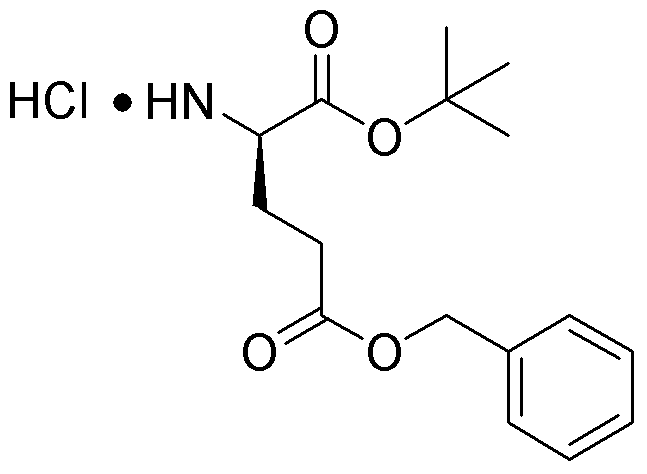D-Glutamic acid g-benzyl ester a-tert-butyl ester hydrochloride is widely utilized in research focused on:
- Pharmaceutical Development: This compound serves as an important intermediate in the synthesis of various pharmaceuticals, particularly those targeting neurological disorders, due to its structural similarity to neurotransmitters.
- Biochemical Research: Researchers use it to study amino acid metabolism and protein synthesis, providing insights into cellular processes and potential therapeutic targets.
- Peptide Synthesis: It is employed in the production of peptides, enhancing the efficiency of coupling reactions and improving yield in peptide-based drug formulations.
- Food Industry: The compound can be used as a flavor enhancer or as a component in food additives, contributing to umami taste profiles in various culinary applications.
- Cosmetic Formulations: Its properties make it suitable for use in skincare products, where it can act as a stabilizer and enhance the texture of creams and lotions.
General Information
Properties
Safety and Regulations
Applications
D-Glutamic acid g-benzyl ester a-tert-butyl ester hydrochloride is widely utilized in research focused on:
- Pharmaceutical Development: This compound serves as an important intermediate in the synthesis of various pharmaceuticals, particularly those targeting neurological disorders, due to its structural similarity to neurotransmitters.
- Biochemical Research: Researchers use it to study amino acid metabolism and protein synthesis, providing insights into cellular processes and potential therapeutic targets.
- Peptide Synthesis: It is employed in the production of peptides, enhancing the efficiency of coupling reactions and improving yield in peptide-based drug formulations.
- Food Industry: The compound can be used as a flavor enhancer or as a component in food additives, contributing to umami taste profiles in various culinary applications.
- Cosmetic Formulations: Its properties make it suitable for use in skincare products, where it can act as a stabilizer and enhance the texture of creams and lotions.
Documents
Safety Data Sheets (SDS)
The SDS provides comprehensive safety information on handling, storage, and disposal of the product.
Product Specification (PS)
The PS provides a comprehensive breakdown of the product’s properties, including chemical composition, physical state, purity, and storage requirements. It also details acceptable quality ranges and the product's intended applications.
Certificates of Analysis (COA)
Search for Certificates of Analysis (COA) by entering the products Lot Number. Lot and Batch Numbers can be found on a product’s label following the words ‘Lot’ or ‘Batch’.
*Catalog Number
*Lot Number
Certificates Of Origin (COO)
This COO confirms the country where the product was manufactured, and also details the materials and components used in it and whether it is derived from natural, synthetic, or other specific sources. This certificate may be required for customs, trade, and regulatory compliance.
*Catalog Number
*Lot Number
Safety Data Sheets (SDS)
The SDS provides comprehensive safety information on handling, storage, and disposal of the product.
DownloadProduct Specification (PS)
The PS provides a comprehensive breakdown of the product’s properties, including chemical composition, physical state, purity, and storage requirements. It also details acceptable quality ranges and the product's intended applications.
DownloadCertificates of Analysis (COA)
Search for Certificates of Analysis (COA) by entering the products Lot Number. Lot and Batch Numbers can be found on a product’s label following the words ‘Lot’ or ‘Batch’.
*Catalog Number
*Lot Number
Certificates Of Origin (COO)
This COO confirms the country where the product was manufactured, and also details the materials and components used in it and whether it is derived from natural, synthetic, or other specific sources. This certificate may be required for customs, trade, and regulatory compliance.


